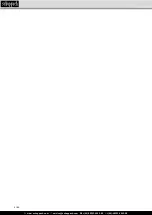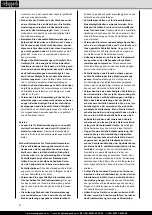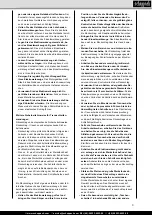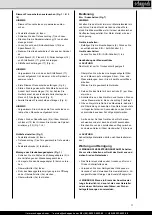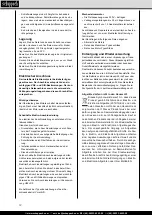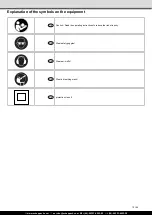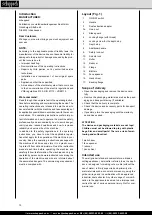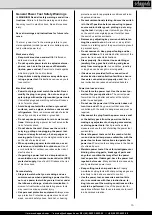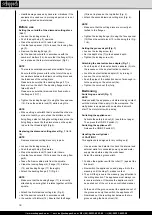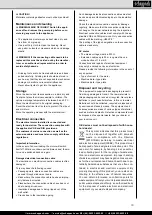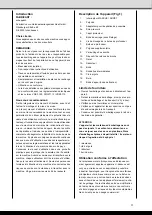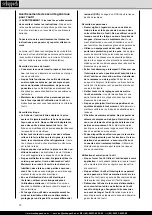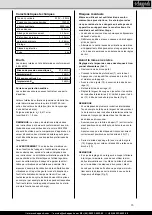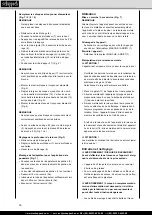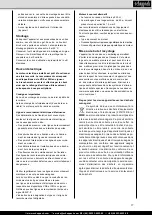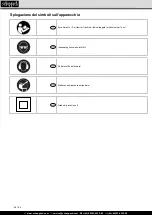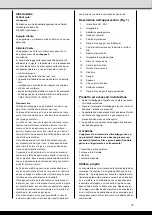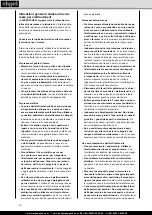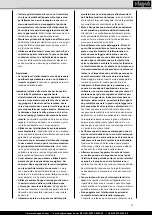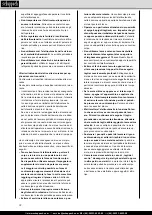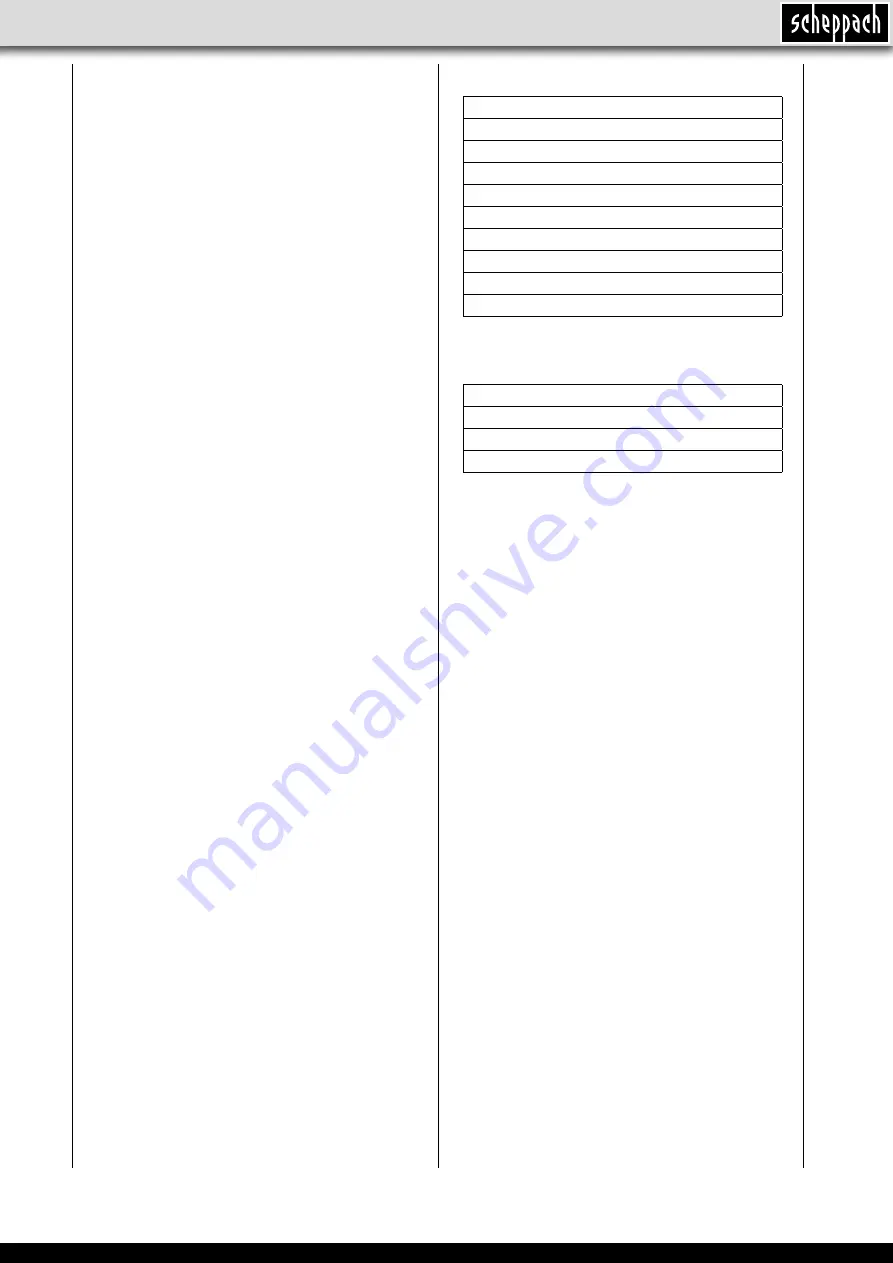
17
www.scheppach.com
service@scheppach.com
+(49)-08223-4002-99
+(49)-08223-4002-58
www.scheppach.com
service@scheppach.com
+(49)-08223-4002-99
+(49)-08223-4002-58
A kickback is caused by incorrect use or misuse of the
power tool. This can be avoided by taking proper pre
-
cautions as given below.
•
Hold the power tool firmly in both hands and
position your arms so they can absorb the force
of a kickback. Always use the additional handle,
if available, so you have the maximum control
over the kickback force or reaction torques at
full speed.
By taking adequate precautions, the
operator can stay in control of the kickback and
reaction torques.
•
Never hold your hand close to a rotating acces-
sory tool.
The accessory tool could hit your hand in
the case of a kickback.
•
Avoid the area in front of and behind the rotating
cutting disc.
The kickback will force the power tool
in the opposite direction to the direction of rotation of
the grinding disc at the blockage.
•
Take special care when working around corners,
sharp edges, etc. Avoid allowing the accessory
tool to bounce back from the workpiece or jam.
The rotating accessory tool is more likely to jam in
corners or sharp edges or if it bounces. This can
cause a loss of control or kickback.
•
Do not use a toothed or chain saw blade or seg-
mented diamond-coated disc with more than 10
mm wide slits.
Such accessory tools cause a kick
-
back or loss of control over the power tool.
•
Avoid cutting disc jams or excessive contact
pressure. Do not make any excessively deep
cuts.
Overloading the cutting disc increases the
stress and likelihood of tilting or jamming and thus
the possibility of kickback or breakage of the grin
-
ding tool.
•
If the cutting disc jams or you stop working,
switch the tool off and hold it steady until the
disc has completely stopped turning. Never att-
empt to pull a rotating cutting disc out of a cut.
This could lead to kickback.
Identify and remove
the cause of the jam.
•
Do not switch the power tool back on as long as
it is in the workpiece. Allow the cutting disc to
reach its full speed before you carefully continue
the cut.
Otherwise, the disc may jam, jump out of
the workpiece or cause kickback.
•
Support panels or large workpieces to reduce
the risk of the cutting disc jamming and causing
a kickback.
Large workpieces can bend under their
own weight. The workpiece must be supported on
both sides, namely in the vicinity of the cut and also
at the edge.
•
Be particularly careful when making „pocket
cuts“ into existing walls or other obscured are-
as
. The inserted cutting disc may cut into gas or
water pipes, electrical wiring or other objects that
can cause kickback.
Technical data
Input voltage
230 V~, 50 Hz
Power consumption
1350 W
Rated speed
9000 /min
Disc sizes Ø
125 mm
Central fixing bore
22.2 mm
Groove depth
0 - 30 mm
Groove widths
8 - 26 mm
Thread
M14
Protection class
II
Weight
4 kg
Noise
Total noise values determined in accordance with EN
60745.
sound pressure level L
pA
97.6 dB(A)
uncertainty K
pA
3 dB(A)
sound power level L
WA
108.6 dB(A)
uncertainty K
WA
3 dB(A)
Wear hearing protection.
The effects of noise can cause a loss of hearing.
Total vibration values (vector total of three directions)
determined in accordance with EN 60745. Details of
vibration values (when cutting off a concrete plate):
Main handle: a
h
= 6,417 m/s
2
Uncertainty K = 1,5 m/s
2
NOTE:
The vibration level specified in these instruc
-
tions has been measured in accordance with a stan
-
dardised measuring procedure specified in EN 60745
and can be used to make equipment comparisons.
The specified vibration emission value can also be
used to make an initial exposure estimate.
m
WARNING!
The vibration level varies in accordance
with the use of the power tool and may be higher than
the value specified in these instructions in some ca
-
ses. There is a risk of underestimation of the vibration
load if the power tool is used regularly in this manner.
Try to keep the vibration loads as low as possible.
Measures to reduce the vibration load are, e.g. wea
-
ring gloves and limiting the working time. Wherein all
states of operation must be included (e.g. times when
the power tool is switched off and times where the po
-
wer tool is switched on but running without load).
Residual risks
Even if you use this electric power tool in ac-
cordance with instructions, certain residual risks
cannot be rules out. The following hazards may
arise in connection with the equipment’s const
-
ruction and layout:
•
Lung damage if no suitable protective dust mask is
used.
•
Damage to hearing if no suitable ear protection is
used.


